Archives for workouts (page 20)
March 3, 2004
Short and sweet
The stiff-legged deadlifts I did on Friday hit my poor hamstrings with a vengeance. During the weekend they were so sore that I could not even fully extend my left knee joint. If it wouldn’t have been for the light posterior chain massage Sanna gave me, I probably would not have stopped limping by Monday as I did now. This is what happens when you get a back injury, take three months off the movement, and then go for sets of ten…
As speed squatting was ruled out by a nasty lingering soreness, the only sensible option was to hit only the abs, calves and grip. I think I am going to hit the stiffs next week as well. Hamboys, you better be prepared this time around!
By the way, I received Brent Mikesell’s Hardcore Powerlifting Video yesterday, which turned out to be a very enjoyable video. I have now amassed a small pile of powerlifting videos plus some books (most recently Ryan Kennelly’s The Kennelly Method) that keep reminding me that I should review them in order to give my Squatting Secrets review some much anticipated company. So don’t think I’ve forgotten. Just busy. The patient ones among you will be rewarded. Eventually.
Twisting ab machine: 4x12 @ 40 kg/88 lbs
Standing calf raise: 8,8,8,6 @ 140 kg/309 lbs
Captains of crush grippers: 12,5 @ I, 25 @ Trainer
Lying leg curls: 12 @ 25 kg/55 lbs (to flush some blood there, boy they were stiff!)
Total training time: 20 min
March 1, 2004
The Amazing Adventures of CG Max
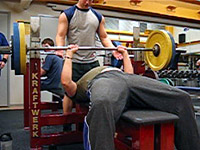 New month, new adventures. For the first time since my first wavering steps into the world of powerlifting last May, I slid my hands in close - index fingers at smooth - to find out if my close grip max is indeed in the neighborhood of my 1RM bench. After last week’s less than stellar performance on the bench, I did indeed punch up 97.5 kg/215 lbs to lockout after a near failure at 100 kg/221 lbs (first time this trick ever worked!). Reattempted 100 kg/221 lbs some five minutes later, but by now the fatigue made that attempt an embarrassment for all. This means that I will embark on the new six-week benching program with the same max weight for the wide and close-grip benches. Weirdness does happen.
New month, new adventures. For the first time since my first wavering steps into the world of powerlifting last May, I slid my hands in close - index fingers at smooth - to find out if my close grip max is indeed in the neighborhood of my 1RM bench. After last week’s less than stellar performance on the bench, I did indeed punch up 97.5 kg/215 lbs to lockout after a near failure at 100 kg/221 lbs (first time this trick ever worked!). Reattempted 100 kg/221 lbs some five minutes later, but by now the fatigue made that attempt an embarrassment for all. This means that I will embark on the new six-week benching program with the same max weight for the wide and close-grip benches. Weirdness does happen.
The several heavy attempts made this an awfully slow workout. As you can see and hear on the video clip (2.9M) there was quite a gathering at the gym around 7pm. I usually train around 3pm when the air is fresh and the music pristine. Quickly did some rows and an incline hammer curl/incline tate press superset and hit the shower content. Let this be the last time my max bench, with any grip, fails below 100 kg/221 lbs! So there.
Close-grip bench:
5 @ 40 kg/88 lbs
5 @ 50 kg/111 lbs
3 @ 60 kg/133 lbs
1 @ 70 kg/155 lbs
1 @ 80 kg/177 lbs
1 @ 90 kg/199 lbs
1 @ 95 kg/210 lbs
0 @ 100 kg/221 lbs
1 @ 97.5 kg/215 lbs
0 @ 100 kg/221 lbs
T-bar row, chest supported: 8,8,5 @ 60 kg/133 lbs, 15 @ 35 kg/77 lbs
2 supersets:
Incline hammer curl: 10,8 @ 16 kg/35 lbs
Incline tate press: 6,3 @ 16 kg/35 lbs
Total training time: 75 min
February 27, 2004
Stiff-legged cause for celebration
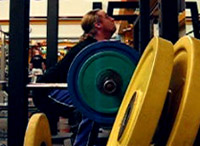 Zercher squats off the second pins was today’s max effort squat movement. Watching the first taped set with 60 kg/133 lbs, I noticed that I was not sitting back far enough instead leaning over to pick the weight up (the easy way for me). On the subsequent sets I tried sitting back more with some success, but the shins were still not as nicely vertical as when I did them free standing some weeks ago. Then I had a problem with the upper body dipping forward on ascent; this time I had better hip drive and there was much less forward dipping, but this might be something of an illusion as I started with more forward lean. For more of a challenge, I could consider starting one notch lower next time, which would also allow me to place the bar in front of the knees properly. VIDEO (2.9M)
Zercher squats off the second pins was today’s max effort squat movement. Watching the first taped set with 60 kg/133 lbs, I noticed that I was not sitting back far enough instead leaning over to pick the weight up (the easy way for me). On the subsequent sets I tried sitting back more with some success, but the shins were still not as nicely vertical as when I did them free standing some weeks ago. Then I had a problem with the upper body dipping forward on ascent; this time I had better hip drive and there was much less forward dipping, but this might be something of an illusion as I started with more forward lean. For more of a challenge, I could consider starting one notch lower next time, which would also allow me to place the bar in front of the knees properly. VIDEO (2.9M)
Worked up to a single at 80 kg/177 lbs and stopped there figuring that 5 kg/11 lbs more on the bar could cause my back to round, a risk I was not quite willing to take yet. Picking stiff-legged deadlifts, a severe back rounder, for my second exercise is not at all paradoxical as there is a huge difference between doing singles and sets of ten. Pyramided up to a set at 90 kg/199 lbs, which reassured me that my back is indeed in quite good shape now. Might not take so long before I start repping with 120 kg/265 lbs again.
But let’s not pretend I am quite 100% healed yet. I still get a cold sensation at the location of the injury when training, which could be indicative of scar tissue. Am thinking about seeing a sports massage therapist or something next week.
Zercher squat off 2 pin:
5 @ 40 kg/88 lbs
5 @ 50 kg/111 lbs
5 @ 60 kg/133 lbs
1 @ 70 kg/155 lbs
1 @ 75 kg/166 lbs
1 @ 80 kg/177 lbs
Stiff-legged deadlift:
10 @ 50 kg/111 lbs
10 @ 70 kg/155 lbs
10 @ 80 kg/177 lbs
10 @ 90 kg/199 lbs
Standing cable crunch, lat pulley: 7,7,6,5 @ 45 kg/99 lbs
Hyperextensions: 15
Total training time: 58 min (took it slow and easy today)
February 25, 2004
Blakley’s 4x6 bench program and a load of question marks
Skipped Monday’s DE Squat/Deadlift workout due to personal reasons (yes, there are such things). I’ve been thinking a lot about what to do next as far as a bench program goes. Started a thread over at Westsidebar.net presenting my current situation, sticking point and all, and inquiring about Blakley’s program as he presents it on the XTM video (the thread for those of you who read Finnish). Below is a rough outline of the program:
JM Blakley’s 4x6 Bench routine
I. BENCH DAY
Pattern warm-up (mental and physical readiness)
* for example: 10, 8, 6, 4, 2, 2 (nothing too heavy)Skill and neuromuscular work
* 2-3 sets of singles with near max weight, but light enough to be a sure thing with perfect form (around 85% of raw max)
* For a shirt trainer the same pattern with the shirt (2-3 x 1 @ c. 90% of shirt max); should be done at least every other weekActual training sets
* bench with pause 4 sets of six starting at the raw 6RM. Stay at this weight until you get six reps on all sets and then raise 5 lbs and start over …and so on ad infinitumII. ACCESSORY DAY (usually triceps)
Basic warm-up
Training sets
4 sets of six in the same manner as on the Bench day for two exercises (for example, board press 4x6, JM Press 4x6). Exercises are changed when they start to go stale, roughly every 8 to 12 weeks.COMMENTS
Speed work can be added last on both training days as long as it is light enough not to raise a recovery demand. Closer to a meet or peaking event, the weight can be raised to 4x3 for four to eight weeks. Depending on the weaknesses of the lifter, the Bench day or the Accessory day can be exchanged for a shoulder cycle, an A/C repair cycle or a chest drive cycle. For details on these and examples of a lot of exercises get the video. You won’t regret it!!
Nobody had tried the routine, but it turned into a very helpful thread as far as my bench is concerned. Below are some of the main comments in random order:
- The bench analysis is nice. Do work from just below the sticking point (pin presses, 1-3 board press). Speed off the chest looks good, so cut back on the floor presses, illegal wides and dumbell benches.
- I raised some concern about the high reps used in the 4x6 protocol, which was echoed by the board. Close to aerobics someone said jokingly. Well, it is only one step away from a 5x5 program so we should not debunk it just based on this although it sure is not very typical (JM’s merits as a lifter vouches for this program if nothing else).
- 8 to 12 weeks of the same two accessory movements sounds like much based on the experience of some of the lifters who claim to go stale “already” after 4 to 5 weeks. Perhaps some sort of cycling needs to be done, but again, I think the program should be tested as is before final judgment is passed.
- Possible remedies for the sticking point: do close grip benches and shorts leaving the bar just above the chest. Also consider flaring the elbows out towards the lockout instead of keeping them tucked throughout. This last suggestion made me more confused than anything else since at least the Westside crew seem to/used to advocate keeping them tucked throughout. You do see plenty of elbow flaring on shirt benches, but I was under the impression that raw benchers should tuck for queen and country. Started a thread on the nazbar forum to get another view:
Elbow flaring on raw bench?
Kris:
Quick question from a confused novice raw bencher: should one flare the elbows towards the lockout or keep them tightly tucked throughout the press when benching raw? Would the answer vary according to possible weak points? I get stuck about 1/3 of the way up (just below the 3 board mark). I bench with pinkies on the rings.BTW, thanks for maintaining such a great forum! Your power is contagious.
vdizenzo (Vincent Dizenzo):
I like to press in a straight line over my lower chest/belly, thus keeping my elbows in until lockout. Whereas, one of my training partners starts drifting the bar back and flaring his elbows after the initial pop off the bottom. What I recommend is video taping your lifts and critiquing your own style. My lifts improved greatly from watching them on video. Good luck.A good way to test the effect of elbow flaring would be to do some shorts or pin presses with both tucked elbows and elbows wide and compare the results.
- To alleviate sticking points between the chest and the 1/3 mark narrowing the grip it is often recommended. One lifter commented that he had precisely the same problem, but he was helped by doing just the opposite, i.e. widening the grip. Basically a close grip gives better drive off the chest, a wide grip makes it easier to lock out.
- It was suggested that I might want to consider trying some more basic training (such as a Bench program based on Prilepin’s table that several of the lifters have gotten good results from) and forget about the sticking point for now. Bench, bench and bench some more.
Great thread that is still alive. Thanks to Tenu, Force, admin, OP, Tepes and Mane for all the helpful thoughts and suggestions!
After great mental agony I have concluded the following about my bench program. I won’t start to play around with my elbows just yet as I’m still in the process of honing my form in other areas and flaring the elbows would probably just serve to break a functioning package. Instead I will forget about the sticking point (damn right I will) and do the suggested bench program based on Prilepin’s table that the board swears by. Basically, there will always be a sticking point somewhere and I will simply aim at getting 110 kg/243 lbs to stick there in style. My main target is to get my bench within the range defined by the bench guessing competition I arranged by early June. No frills, basic training will hopefully take me there.
I am going to take a break off the fancy board work, pin presses & Co, instead focusing on full-range motion that many raw benchers say are the foundation (shirt benchers get great assistance from the shirt at the bottom, therefore board work etc. targeting more of the lockout phase is most helpful). In another thread at nazbar, Jim Wendler, Mike Miller and others suggested, besides wisening up and buying a shirt, the following assistance exercises for raw benchers:
- Flyes to strengthen the pec delt tie in
- Neutral grip dumbell presses/incline presses
- Bradford Presses
- Chains suspended pushups with feet elevated and an average band around back
- Illegal wide grip bench presses
- Low pin rack lockouts
- Exercises with a close-grip
Next Monday I will test my close grip bench max as I need to input that into the calculations for the Prilepin Bench program. I can then start the program the following week. Will present the program later, perhaps even create a script for it. And Blakley’s program? Still interested, but not now. Naturally, I am interested in hearing about any reader experiences with this program.
Today I did a standard DE Bench day based on my current routine. Not one of my better training sessions.
This was another loooong postaaah, so I am going to lighten up the tune with some great quotations from Blakley’s video:
“I don’t believe in plateaus”
“If you think there are plateaus you’re wrong!”
“The program never fails”
“There is no such thing as waiting too long between sets”
“There is no substitute for progress, folks”
Towards the end of the video there was a close call…
“…he was stuck at a plateau… well, not a plateau… well, he was inching along”
Great video!! Get it now.
Speed bench; narrow, medium, wide: 9x3 @ 60 kg/133 lbs
Lying dumbell triceps extension: 5,2 @ 20 kg/44 lbs; 6 @ 18 kg/40 lbs
Pulldown, parallel grip: 4x6 @ 95 kg/210 lbs
Superset:
One-handed rear cable raise: 11 @ 15 kg/33 lbs
One-handed side cable raise: 11 @ 8 kg/33 lbs
One-handed front cable raise: 5 (right) / 3 (left) @ 15 kg/33 lbs
Total training time: 33 min
February 20, 2004
The science of Sticking Points
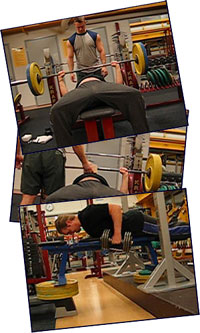 Went hunting for my bench sticking point today to see whether it was still where it used to be. Didn’t even have time to don my safari hat and khaki pants before I found my pray at a disappointing 95 kg/210 lbs. Yes, I have been sick, but I still found it disturbing to get stuck at a weight I have easily pushed up in training since early December. The previous set at 90 kg/199 lbs was totally out of groove so perhaps I wasn’t totally with it. No matter. The sticking point is where it used to be, which was confirmed by my next exercise, two board presses, where the bar stalled at the same height with 100 kg/221 lbs (got 95 kg/210 lbs easily).
Went hunting for my bench sticking point today to see whether it was still where it used to be. Didn’t even have time to don my safari hat and khaki pants before I found my pray at a disappointing 95 kg/210 lbs. Yes, I have been sick, but I still found it disturbing to get stuck at a weight I have easily pushed up in training since early December. The previous set at 90 kg/199 lbs was totally out of groove so perhaps I wasn’t totally with it. No matter. The sticking point is where it used to be, which was confirmed by my next exercise, two board presses, where the bar stalled at the same height with 100 kg/221 lbs (got 95 kg/210 lbs easily).
Being in the gym around midnight is a good opportunity to do fancy setups, so banged out some reps of lying dumbell rows on a bench I raised with a stepup box and some plates. Then barbell curls (darn my biceps are weak) and reverse grip tricep pressdowns. Not a great workout, but at least I am not sick anymore which is great. The video is here (4.7M).
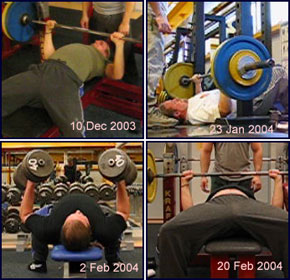 Enough already, let’s get back to the sticking point which we are about to dissect with academic precision. Looking at the comparison to the right (-> this way folks!) we see that not much has happened despite a focus on floor presses, illegal wides and dumbell presses during the last few weeks. I still get stuck quite precisely one third of the way up.
Enough already, let’s get back to the sticking point which we are about to dissect with academic precision. Looking at the comparison to the right (-> this way folks!) we see that not much has happened despite a focus on floor presses, illegal wides and dumbell presses during the last few weeks. I still get stuck quite precisely one third of the way up.
Quite precisely, sir? Yes, my good man. Remember the comparison pictures I took last week of all the pin, board and floor presses with close, medium and “wide” (I currently press with the pinkies at the rings, i.e. fairly narrow) grips? What I did was to scale them to the same size and align them. Using the three pin press as the bottom guide (precisely at chest), approximating the lockout height from the six pin press, and extracting the sticking point from today’s board press and my recent floor press, I got a nice comparative chart showing every exercise in relation to my sticking point. One third it is. Click the chart below to see the full version.
The chart tells me that floor presses, four pin presses and three board presses are right on the money. Combine those with more dumbell work, illegal wides and speed work to raise starting strength and explosivity and things should happen. The lockout is not really a problem at the moment. The good thing about this chart is that I can reuse it if my sticking point changes (I will make sure it does). This way I can always see which exercises hit my sticking point the closest. To state the obvious, I must say that I am pretty proud of this chart. Can’t wait to do the same for the deadlift and squat.
With the sticking point being approximately at the height of the three boards, it is not all that surprising that my max from the three boards equals that of the two boards which more or less equals what I can usually get off the bench (look especially at October 2003…). Go higher than that and I can start to lockout significantly more weight. To the lay person it would seem that the higher you go the more weight you can lock out, but this is not simply true for everybody as bar speed and drive needs to be taken into account.
One Sunday, I was lifting with Dave in London, Ohio and after our dynamic bench presses we moved into lockouts. For the record, Dave’s best bench press is 605 and mine is 575. We moved to high pin lockouts and started with 315. After my set, we moved to 365 and Dave started to psyche himself up. At first I thought he was joking, and laughed at him. He stared back at me, grabbed the bar and proceeded to grind out 3 reps. I think he ended up doing 455 for 2 reps and burst every blood vessel in his face in the process. I moved to doing 500 for two easy sets of 3 reps. So how did he bench 605 and but can barely lockout 450? It has to do with bar speed. Without that component, Dave would have never come close to bench pressing over 600lbs.
Jim Wendler: Beginner Mistakes, Part II
My progress chart also reveals that I have not made all that much progress since I last got academic with my bench at New Year’s Eve. The times are simply gone when I could add 10 kg/22 lbs to my bench every few weeks. I am making some progress in floor presses and such, but I could both physically and mentally really use a period of doing something radically different than going for singles every week. Preliminary, the 4x6 program JM Blakley outlines on his XTM Bench video combined with standard Westside training for the squat/deadlift could be a possibility. Naturally I would still focus on the assistance exercises for my sticking point, but the rep scheme and rotation would be different than what I have been doing for the last half year or so. I’ll have to make up my mind this weekend about what to do. Winds of Change and such.
Bench:
5 @ 40 kg/88 lbs
5 @ 50 kg/111 lbs
3 @ 60 kg/133 lbs
3 @ 70 kg/155 lbs
1 @ 80 kg/177 lbs
1 @ 90 kg/199 lbs
0 @ 95 kg/210 lbs (ouch!)
Two-board press, wide-grip:
5 @ 50 kg/111 lbs
5 @ 70 kg/155 lbs
3 @ 80 kg/177 lbs
1 @ 90 kg/199 lbs
1 @ 95 kg/210 lbs
0 @ 100 kg/221 lbs
Lying dumbell row: working up to 10,8,8 @ 26 kg/58 lbs
2 supersets:
Standing barbell curl: 5 @ 45 kg/99 lbs
Pressdown, reverse-grip: 12 @ 70 kg/155 lbs
Total training time: 72 min (so much for intensity…)
February 12, 2004
Know thy tools
I have been thinking a little about my bench lately, more specifically about improving strength at my sticking point. Looking at the picture where I got stuck with the 40 kg/88 lbs dumbells on dumbell benches tells me I have more of a lockout problem than a start problem (weak triceps) as the bar got stuck fairly high. It sure didn’t feel all that high, but the camera does not lie (I hope).
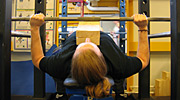 Besides working on increasing speed to get the bar moving faster towards the sticking point, one remedy often recommended for half way/high sticking points is board presses and pin presses/rack lockouts done from the sticking point to lockout. To do this you need to know two things: 1) where your sticking point is and 2) which variety of board (two board? three board?) and pin presses (fourth hole? fifth hole?) start from that height. To pave the ground for number two, I brought the camera with me today and took shots of board, pin and floor presses with a wide, medium and narrow grip. Next week’s Wednesday I plan to go for another bench max. It should then be trivial to compare the angle of the upper arms in the board and pin presses at various starting heights to the angle the arms are at my sticking point. Once I got that I will focus on doing more work at my sticking point and see what happens.
Besides working on increasing speed to get the bar moving faster towards the sticking point, one remedy often recommended for half way/high sticking points is board presses and pin presses/rack lockouts done from the sticking point to lockout. To do this you need to know two things: 1) where your sticking point is and 2) which variety of board (two board? three board?) and pin presses (fourth hole? fifth hole?) start from that height. To pave the ground for number two, I brought the camera with me today and took shots of board, pin and floor presses with a wide, medium and narrow grip. Next week’s Wednesday I plan to go for another bench max. It should then be trivial to compare the angle of the upper arms in the board and pin presses at various starting heights to the angle the arms are at my sticking point. Once I got that I will focus on doing more work at my sticking point and see what happens.
After the shots, I did the second workout of my light week. Began with illegal wide benches and worked up to a very near failure with a triple at 80 kg/177 lbs. I had thought I would handle a little more than this, and can only hope that this “max attempt” does not offset the effect of this light week as far as the bench is concerned. With the overall volume kept low, I don’t think this one set matters much.
Illegal wides:
5 @ 50 kg/111 lbs
5 @ 60 kg/133 lbs
5 @ 70 kg/155 lbs
3 @ 80 kg/177 lbs
Pulldown, close-grip: 2x10 @ 80 kg/177 lbs
Pressdown: 15 @ 30 kg/66 lbs
Seated cable L-flye: 12 @ 10 kg/22 lbs
Standing one-handed cable curl: 12 @ 25 kg/55 lbs
Captains of Crush grippers: 35 (right), 20 left (!?) @ Trainer
Total training time: 30 min
February 11, 2004
Calf raise propaganda
Appropriate for a light squat/deadlift workout, I did some very light speed deadlifts for the first time since the lower back injury. No nasty surprises, but I was glad that this was not a ME day calling for risky machismo.
I got the Westside Squat Workout tape from Elite Fitness Systems a few days ago. After seeing the Squatting Secrets tape (my review), watching clips on the net and reading a lot of Westside articles there was not too many revelations left for this tape (the action was still great of course!). Among the gold nuggets I picked up was calf raises done standing on the floor with a barbell on the back. Compared with doing raises off a calf board this movement is half range, but it should provide a better carry over to squatting/deadlifting stability as it is done with the same equipment (barbell), same stance and same posture.
If done with a wide squat stance, this movement will also hit the calves in a way difficult with a machine. In a calf machine the legs will usually be pretty straight (knees in line with heels), but here the angle of the legs puts the knees way to the inside of the heels forcing much of the weight towards the big toe. Admittedly you could just buckle in the knees doing calf raises in a machine with a narrow stance, but I seriously doubt that the effect will be as dramatic as with a barbell and a wide stance. The fact that I almost failed doing ten reps at 90 kg/199 lbs tells me that it matters little that I can move some serious weight on a standing calf raise or a donkey calf press.
Speed deadlift:
3x10 @ 50 kg/111 lbs
10 @ 70 kg/155 lbs
Twisting ab machine: 4x12 @ 30 kg/66 lbs
Ball crunch: 15 @ 5 kg/11 lbs
Barbell calf raise, squat stance:
10 @ 60 kg/133 lbs
10 @ 80 kg/177 lbs
10 @ 90 kg/199 lbs
Total training time: 24 min
February 4, 2004
Tender moments
Monday’s dumbell benches and illegal wides left some major pec soreness behind. Thought that this would be an ideal moment to try some restoration work by increasing blood flow to the sore muscles. It is usually recommended that the extra work is done some 4-24 hours after the main workout. As muscle soreness tends to peak about 48 hours after the workout, this means that the need for extra workouts has to be predicted well before soreness hits with full force. Did some supersets for the chest, back and arms anyway figuring that some late arriving blood would probably still be better than nothing. Felt good, but the ball presses were perhaps a tad too heavy for my pecs gasping for relief even with only 10 kg/22 lbs dumbells. Ditto for the cable curls. Lesson learned: go lighter than light.
After standing up well to heavier zercher and box squats, I decided to pass on the speed box today to reward the lower back with some well deserved extra rest. It won’t be long now before I will be ready to start going after and beyond my maxes in the squat/deadlift exercises.
What was left then was some heavy ab, calf and grip work. Haven’t done the Captains of Crush grippers in a long while, yet they felt quite light and I got the number ones more closed throughout the sets than before. I could probably start working on the number two gripper for negatives. That would necessitate ordering one first though.
Speaking of the devil: a copy of JM Blakley’s XTM Bench I ordered through a special over at Voimaharjoittelu.net arrived today. This video seems to be somewhat hard to come by. I know Elite Fitness Systems have stocked it in the past, but now I couldn’t locate it anywhere except for at Voimaharjoittelu.net. Even JM Blakley’s home page currently returns a Please visit this site later; under construction. This 3 hour video will have to wait until tomorrow, but the anticipation runs high as Building the Perfect Beast was a really really great video. I have heard that it is shot in black & white and is fuzzy etc. apparently to give it a more hardcore air. This has made some people really upset accusing him of covering up bad production with a HC label. I am expecting a mixed bag of nuts, perhaps a little like the current weather situation here in Helsinki: first it snows like crazy (really) over the weekend, then it starts to rain like hell (really) for the next couple of days. A very vivid small scale example of what will happen if the polar ice starts to melt rapidly.
Supersets:
Pulldown, wide grip: 2x30 @ 30 kg/66 lbs
Stability ball dumbell bench: 2x25 @ 10 kg/22 lbs
Supersets:
Pressdown: 2x30 @ 20 kg/44 lbs
Standing cable curl: 25,20 @ 20 kg/44 lbs
Spread eagle sit-up:
7,4 @ 10 kg/22 lbs
10,6 @ 5 kg/11 lbs
17 @ bodyweight
Seated calf raise: 3x8 @ 80 kg/177 lbs
Captains of Crush grippers:
12 @ I
24, 13 @ Trainer (two reps more with right)
Total training time: 27 min
February 2, 2004
Dumbells looking for groovy company
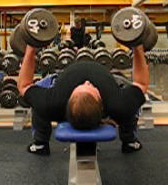 Monday has turned into traditional short sleep day. A nap before the workout helped some and loading Kalmah into the CD player helped some more. I was training very near closing time, so the number of potential complaints about the music where few. In fact, it turned out that one of the guys training was a die hard Kalmah and death metal fan. I had him scribble down some names of other Scandinavian bands in the genre that he considered to be melodic: Dark Tranquility, Godgory, Inflames and Vintersorg. All unfamiliar to me (no surprise here), will have to peruse their homepages for samples later on.
Monday has turned into traditional short sleep day. A nap before the workout helped some and loading Kalmah into the CD player helped some more. I was training very near closing time, so the number of potential complaints about the music where few. In fact, it turned out that one of the guys training was a die hard Kalmah and death metal fan. I had him scribble down some names of other Scandinavian bands in the genre that he considered to be melodic: Dark Tranquility, Godgory, Inflames and Vintersorg. All unfamiliar to me (no surprise here), will have to peruse their homepages for samples later on.
Consistent with my quest to improve benching power off the chest, I camped with the dumbells for my first exercise. My previous, and first, encounter with dumbell benches date back to Christmas Eve when I got 3 reps with 38 kg/84 lbs. Back then I noted some problems with my groove, a sentiment that was echoed today. The 36 kg/80 lbs set was especially bad, when the left dumbell drifted off course for the last rep leaving me to press it up with no power off the bottom. No big improvements; got one rep more with 36 kg/80 lbs than last time but my last set ended up at the same three reps with 38 kg/84 lbs. Tried the 40 kg/88 lbs dumbells, but couldn’t get past my sticking point (picture at right). The first rep is always hell with heavy bells… hells bells?
Tried illegally wide benches as my chest/tri assistance movement. Worked up to a fairly easy fiver with 70 kg/155 lbs and then stayed at that weight for two more quick sets (perhaps 30-40 seconds rest in between). The wide grip didn’t hurt my shoulders, but you can see from the video that the reps were a little wobbly.
Dumbell bench:
10 @ 16 kg/35 lbs
10 @ 20 kg/44 lbs
5 @ 24 kg/53 lbs
5 @ 28 kg/62 lbs
5 @ 32 kg/71 lbs
5 @ 34 kg/75 lbs
5 @ 36 kg/80 lbs
3 @ 38 kg/84 lbs
0 @ 40 kg/88 lbs
Assisted wide-grip pull-up: 6,6,5,4 @ 45 kg/99 lbs
Illegal wides: worked up to 5,5,3 @ 70 kg/155 lbs
2 supersets:
Standing cable curl: 12,10 @ 60 kg/133 lbs
Pressdown: 10,5 @ 80 kg/177 lbs
Total training time: 59 min (did assistance exercise really fast though)
January 30, 2004
First contact
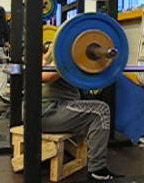 With the Zercher commandos having done good reconnaissance along the Ripped Back frontier, it was time to up the ante and bring in the 13″ box squat. The perimeter being far from secured, I staid a safe sounding 15 kg/33 lbs below my max from the pre-injury days of November. That being said, the last single with 100 kg/221 lbs felt heavy enough after not having maxed out on these for a few months.
With the Zercher commandos having done good reconnaissance along the Ripped Back frontier, it was time to up the ante and bring in the 13″ box squat. The perimeter being far from secured, I staid a safe sounding 15 kg/33 lbs below my max from the pre-injury days of November. That being said, the last single with 100 kg/221 lbs felt heavy enough after not having maxed out on these for a few months.
Tapping the back with a heavier stick was not my only objective today. Pushing the torso forward and the head back was a supremely good reason to get in under the bar after those fairly nasty looking Zerchers. I am happy to report that these looked better (video 3.8M), although things degenerated a little towards the end. It was suggested over at westsidebar.net that the tendency to good morning the weight up might actually be indicative of a strong back and weak legs; first do the easy part (extend the legs), then finish it off with a good morning. I have always wondered what the point of bending the legs in the deadlift is…
One flaw that quite literarily sticks out in the video is the elbows. Next time I vow to keep them aligned under the bar. As Tate writes:
When your elbows turn out toward the back, the bar will drift forward again and end up stapling you to the floor as well as ripping your head off. This is one common mistake I see in all my seminars.
My shins seem to be fairly vertical, but I could definitively sit back a little further. I also need to look into spreading the knees and pushing the feet out. Work to be done, work to be done…
Box squat, 13″:
5 @ 50 kg/111 lbs
1 @ 60 kg/133 lbs
1 @ 70 kg/155 lbs
1 @ 80 kg/177 lbs
1 @ 90 kg/199 lbs
1 @ 100 kg/221 lbs
Pull-through, bent legged: 3x12 @ 90 kg/199 lbs
Standing cable crunch, lat pulley: 3x10 @ 40 kg/88 lbs
Total training time: 48 min
